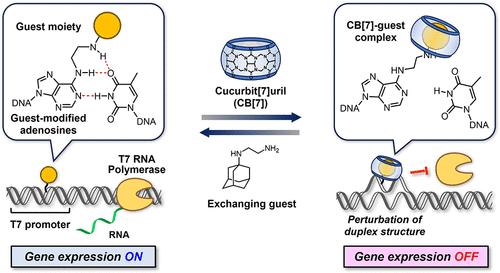当前位置:
X-MOL 学术
›
J. Am. Chem. Soc.
›
论文详情
Our official English website, www.x-mol.net, welcomes your feedback! (Note: you will need to create a separate account there.)
Reversible Control of Gene Expression by Guest-Modified Adenosines in a Cell-Free System via Host–Guest Interaction
Journal of the American Chemical Society ( IF 14.4 ) Pub Date : 2024-06-28 , DOI: 10.1021/jacs.4c04262 Hidenori Okamura 1, 2 , Takeyuki Yao 1, 2 , Fumi Nagatsugi 1, 2
Journal of the American Chemical Society ( IF 14.4 ) Pub Date : 2024-06-28 , DOI: 10.1021/jacs.4c04262 Hidenori Okamura 1, 2 , Takeyuki Yao 1, 2 , Fumi Nagatsugi 1, 2
Affiliation

|
Gene expression technology has become an indispensable tool for elucidating biological processes and developing biotechnology. Cell-free gene expression (CFE) systems offer a fundamental platform for gene expression-based technology, in which the reversible and programmable control of transcription can expand its use in synthetic biology and medicine. This study shows that CFE can be controlled via the host–guest interaction of cucurbit[7]uril (CB[7]) with N6-guest-modified adenosines. These adenosine derivatives were conveniently incorporated into the DNA strand using a post-synthetic approach and formed a selective and stable base pair with complementary thymidine in DNA. Meanwhile, alternate addition of CB[7] and the exchanging guest molecule induced the reversible formation of a duplex structure through the formation and dissociation of a bulky complex on DNA. The kinetics of the reversibility was fine-tuned by changing the size of the modified guest moieties. When incorporated into a specific region of the T7 promoter sequence, the guest-modified adenosines enabled tight and reversible control of in vitro transcription and protein expression in the CFE system. This study marks the first utility of the host–guest interaction for gene expression control in the CFE system, opening new avenues for developing DNA-based technology, particularly for precise gene therapy and DNA nanotechnology.
中文翻译:

在无细胞系统中通过主客体相互作用通过客体修饰的腺苷可逆控制基因表达
基因表达技术已成为阐明生物过程和发展生物技术不可或缺的工具。无细胞基因表达(CFE)系统为基于基因表达的技术提供了一个基础平台,其中转录的可逆和可编程控制可以扩展其在合成生物学和医学中的用途。这项研究表明,CFE 可以通过葫芦[7]尿素 (CB[7]) 与N 6 -客体修饰腺苷的主客体相互作用来控制。这些腺苷衍生物可以通过后合成方法方便地掺入 DNA 链中,并与 DNA 中互补的胸苷形成选择性且稳定的碱基对。同时,交替添加CB[7]和交换客体分子,通过DNA上大体积复合物的形成和解离,诱导双链体结构的可逆形成。通过改变修饰的客体部分的大小来微调可逆性的动力学。当掺入 T7 启动子序列的特定区域时,客体修饰的腺苷能够对 CFE 系统中的体外转录和蛋白质表达进行严格且可逆的控制。这项研究标志着 CFE 系统中主客体相互作用首次用于基因表达控制,为开发基于 DNA 的技术,特别是精确基因治疗和 DNA 纳米技术开辟了新途径。
更新日期:2024-06-28
中文翻译:

在无细胞系统中通过主客体相互作用通过客体修饰的腺苷可逆控制基因表达
基因表达技术已成为阐明生物过程和发展生物技术不可或缺的工具。无细胞基因表达(CFE)系统为基于基因表达的技术提供了一个基础平台,其中转录的可逆和可编程控制可以扩展其在合成生物学和医学中的用途。这项研究表明,CFE 可以通过葫芦[7]尿素 (CB[7]) 与N 6 -客体修饰腺苷的主客体相互作用来控制。这些腺苷衍生物可以通过后合成方法方便地掺入 DNA 链中,并与 DNA 中互补的胸苷形成选择性且稳定的碱基对。同时,交替添加CB[7]和交换客体分子,通过DNA上大体积复合物的形成和解离,诱导双链体结构的可逆形成。通过改变修饰的客体部分的大小来微调可逆性的动力学。当掺入 T7 启动子序列的特定区域时,客体修饰的腺苷能够对 CFE 系统中的体外转录和蛋白质表达进行严格且可逆的控制。这项研究标志着 CFE 系统中主客体相互作用首次用于基因表达控制,为开发基于 DNA 的技术,特别是精确基因治疗和 DNA 纳米技术开辟了新途径。
















































 京公网安备 11010802027423号
京公网安备 11010802027423号